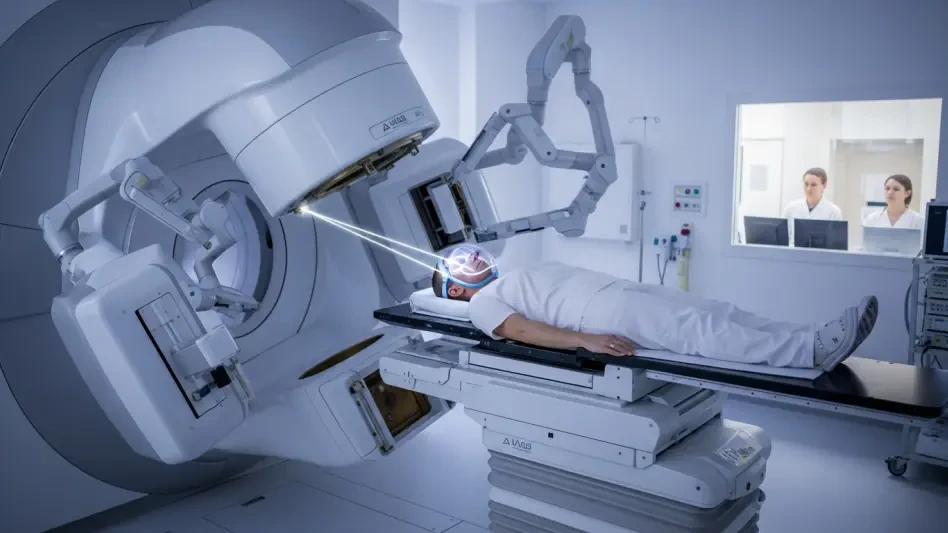In the realm of cancer treatment, precision is paramount, yet millions of patients worldwide still face the devastating side effects of traditional radiation therapies that often harm healthy tissues. Proton therapy, an advanced form of particle therapy, emerges as a beacon of hope, promising targeted destruction of tumors with minimal collateral damage. This cutting-edge technology has captured the attention of medical institutions globally, raising the question of how it can redefine oncology care. This review delves into the intricacies of proton therapy, exploring its technological underpinnings, real-world applications, and transformative potential in the fight against cancer.
Core Principles of Proton Therapy
At its heart, proton therapy leverages high-energy proton beams to attack cancer cells with remarkable accuracy. Unlike conventional X-ray radiation, which releases energy along its entire path through the body, proton therapy capitalizes on a unique physical property that allows energy to be deposited directly at the tumor site. This precision reduces exposure to surrounding healthy tissues, making it a preferred option for treating sensitive cancers in areas such as the brain, spine, and pediatric cases where minimizing long-term damage is critical.
The significance of this technology lies in its alignment with the growing field of precision medicine. As healthcare moves toward individualized treatment plans, proton therapy stands out for its ability to adapt to the specific needs of each patient. Its emergence addresses a critical gap in oncology, offering a solution for tumors located near vital organs where traditional methods pose significant risks.
Technological Features and Performance
Understanding the Bragg Peak
Central to proton therapy’s effectiveness is the Bragg Peak phenomenon, a principle of physics that dictates how protons release their maximum energy at a specific depth before stopping. This allows clinicians to target tumors with pinpoint accuracy, ensuring that the bulk of the radiation dose is delivered precisely where it is needed. Such a mechanism is particularly valuable for complex cases like head and neck cancers or liver tumors, where surrounding structures are highly sensitive.
The implications of the Bragg Peak are profound, especially in pediatric oncology. Children, whose developing tissues are more vulnerable to radiation damage, benefit immensely from this technology as it lowers the risk of secondary cancers and growth abnormalities. This targeted approach marks a significant advancement over traditional therapies, setting a new standard for safety and efficacy in cancer care.
Innovations in Beam Delivery and Precision
Recent strides in proton therapy technology have further enhanced its capabilities, with innovations like ultra-precise beam targeting and adjustable dose delivery systems. These advancements allow medical teams to tailor the beam’s intensity and shape to match the tumor’s exact dimensions and depth, ensuring optimal treatment outcomes. Such customization is a game-changer for patients with irregularly shaped or deeply embedded tumors.
Moreover, the integration of real-time imaging and tracking systems has bolstered the accuracy of proton therapy. These tools enable continuous monitoring of a tumor’s position during treatment, compensating for even slight movements caused by breathing or other physiological factors. This level of control not only improves therapeutic results but also minimizes the risk of unintended side effects, reinforcing the technology’s role in personalized medicine.
Real-World Impact at Korea University Medical Center
One of the most compelling examples of proton therapy in action is the ambitious initiative by Korea University Medical Center (KUMC) through its “Building a Particle Treatment Base” project. This endeavor aims to integrate state-of-the-art proton therapy systems across its network of hospitals, including Anam, Guro, Ansan, and Dongtan 4th Hospital. The goal is to position KUMC as a leading hub for cancer treatment in Korea, focusing on improving outcomes for patients with previously incurable cancers.
KUMC’s strategy goes beyond acquiring advanced equipment; it emphasizes creating a cohesive ecosystem that links treatment, research, and industry collaboration. By implementing cutting-edge specifications and fostering partnerships with international organizations, the center seeks to enhance accessibility and efficiency, ensuring that more patients can benefit from this life-changing technology.
A key aspect of this project is the focus on data-driven innovation. KUMC is developing AI-based treatment planning systems and standardized protocols to refine the precision and safety of proton therapy. These efforts underscore a commitment to not only treating current patients but also shaping the future of oncology through research and systemic integration.
Challenges in Adoption and Implementation
Despite its promise, proton therapy faces significant hurdles in widespread adoption. The high cost of establishing and maintaining proton therapy centers remains a primary barrier, as the infrastructure requires substantial investment in specialized equipment and trained personnel. This financial burden often limits access to the technology, particularly in regions with constrained healthcare budgets.
Technical complexities also pose challenges, as the operation of proton therapy systems demands a high level of expertise and coordination. Additionally, the need for dedicated facilities means that not all medical centers can readily incorporate this technology into their existing frameworks. These obstacles highlight the importance of strategic planning and resource allocation in scaling up proton therapy services.
KUMC is actively addressing these issues through internal reviews, expert consultations, and partnerships aimed at optimizing efficiency. By focusing on sustainable models and enhancing patient access, the center is working to mitigate the economic and logistical constraints, paving the way for broader implementation of proton therapy in clinical settings.
Future Trends and Developments
Looking ahead, the trajectory of proton therapy appears poised for further innovation with the advent of next-generation proton accelerators. These advanced systems promise even greater precision and energy efficiency, potentially reducing treatment times and costs. Such developments could democratize access to proton therapy, making it a viable option for a larger patient population over the coming years.
Another exciting trend is the increasing role of artificial intelligence and clinical research in refining proton therapy protocols. AI-driven algorithms are being designed to analyze vast datasets, optimizing treatment plans based on individual patient profiles. Simultaneously, ongoing studies aim to validate new applications of the technology, expanding its use to a wider range of cancer types.
KUMC’s initiative is expected to play a pivotal role in these advancements, setting benchmarks for global standards in particle therapy. Through its commitment to research and collaboration, starting from this year to at least 2027, the center aims to contribute to breakthroughs that could redefine cancer care on an international scale, solidifying its position as a leader in medical innovation.
Final Thoughts and Next Steps
Reflecting on this review, it becomes evident that proton therapy has carved a niche as a transformative force in oncology, driven by its unparalleled precision and patient-centered outcomes. The exploration of its technological foundations, such as the Bragg Peak and advanced beam delivery, reveals a robust framework that has already begun to change lives. KUMC’s pioneering efforts have demonstrated tangible progress, showcasing how strategic vision and collaboration can overcome adoption challenges.
Moving forward, stakeholders must prioritize investment in cost-effective solutions to make proton therapy more accessible, potentially through modular systems or shared regional facilities. Governments and healthcare organizations should also support training programs to build a skilled workforce capable of operating these complex technologies. Ultimately, fostering global partnerships and open research initiatives will be crucial to unlocking the full potential of proton therapy, ensuring that its benefits reach every corner of the world in the years ahead.









